
|
Now it is very bright as 8.9 mag (Mar. 15, Chris Wyatt). It is observable at 8 mag for a long time from 2022 to 2023. In the Southern Hemisphere, it stays observable for a long time. In the Northern Hemisphere, it is not observable until summer.
Date(TT) R.A. (2000) Decl. Delta r Elong. m1 Best Time(A, h)
Apr. 1 3 43.71 -39 19.7 2.519 2.211 60 8.6 19:46 ( 47, -8)
Apr. 8 3 58.95 -35 37.1 2.608 2.261 58 8.7 19:53 ( 53, -9)
|
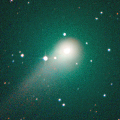
|
Now it is 10.7 mag (Mar. 28, Osamu Miyazaki). It stays bright as 10 mag for a long time until autumn. In the Northern Hemisphere, it becomes unobservable temporarily in early April. But it becomes observable again in summer. In the Southern Hemipshere, it stays unobservable until summer.
Date(TT) R.A. (2000) Decl. Delta r Elong. m1 Best Time(A, h)
Apr. 1 2 10.45 32 13.8 3.012 2.270 35 10.0 19:46 (119, 16)
Apr. 8 2 16.06 30 39.1 3.078 2.256 29 10.0 19:53 (121, 10)
|
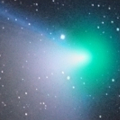
|
It approached to Earth down to 0.29 a.u. in early February, and it brightened up to 4.5 mag (Feb. 1, Juan Jose Gonzalez). Now it is fading. It has already faded down to 10.9 mag (Mar. 28, Osamu Miyazaki). In the Northern Hemisphere, it stays observable until mid April. In the Southern Hemisphere, it stays observable in good condition after this.
Date(TT) R.A. (2000) Decl. Delta r Elong. m1 Best Time(A, h)
Apr. 1 4 52.40 -7 39.4 1.822 1.654 64 10.5 19:46 ( 60, 25)
Apr. 8 4 57.10 -8 40.6 2.000 1.730 59 10.9 19:53 ( 65, 18)
|
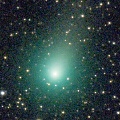
|
It brightened very rapidly. Now it is very bright as 11.0 mag (Mar. 31, Osamu Miyazaki). It will be fading gradually after this. In the Northern Hemisphere, it stays observable for a long time. But it locates low until spring. In the Southern Hemisphere, it is not observable until June.
Date(TT) R.A. (2000) Decl. Delta r Elong. m1 Best Time(A, h)
Apr. 1 23 48.95 43 53.3 2.447 1.818 41 10.6 4:22 (227, 15)
Apr. 8 0 1.03 42 41.0 2.523 1.847 38 10.8 4:11 (228, 15)
|

|
Now it is 13.1 mag (Mar. 30, Chris Wyatt). It is expected to brighten up to 10 mag from spring to summer. However, it is fainter than expected recently. In the Southern Hemisphere, it stays observable in good condition for a long time. In the Northern Hemisphere, it is not observable until 2024 autumn.
Date(TT) R.A. (2000) Decl. Delta r Elong. m1 Best Time(A, h)
Apr. 1 20 8.92 -44 23.8 3.158 3.096 77 10.9 4:22 (328, 0)
Apr. 8 20 16.90 -46 48.5 3.047 3.088 82 10.8 4:11 (330, -2)
|
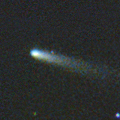
|
Now it is 13.9 mag (Mar. 30, Chris Wyatt). It will brighten very rapidly up to 11.5 mag in April. In the Southern Hemisphere, it stays observable in good condition for a long time. In the Northern Hemisphere, it is not observable from mid April to mid June.
Date(TT) R.A. (2000) Decl. Delta r Elong. m1 Best Time(A, h)
Apr. 1 17 9.31 32 6.2 0.143 1.049 106 12.8 4:22 (327, 87)
Apr. 8 19 41.92 24 10.0 0.121 0.985 78 11.7 4:11 (279, 57)
|
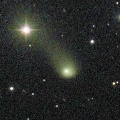
|
Now it is 11.4 mag (Mar. 31, Osamu Miyazaki). It stays 12 mag until summer. It stays observable in good condition for a long time.
Date(TT) R.A. (2000) Decl. Delta r Elong. m1 Best Time(A, h)
Apr. 1 11 50.78 -1 38.7 2.642 3.624 167 11.8 23:11 ( 0, 53)
Apr. 8 11 36.08 -1 55.8 2.681 3.625 157 11.8 22:29 ( 0, 53)
|
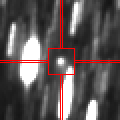
|
Now it is 14.1 mag (Mar. 30, Chris Wyatt). It will brighten very rapidly. It is expected to be observable at 11 mag in excellent condition from spring to summer. It is fainter than this ephemeris recently.
Date(TT) R.A. (2000) Decl. Delta r Elong. m1 Best Time(A, h)
Apr. 1 18 50.90 -20 59.0 1.774 2.018 88 12.1 4:22 (330, 28)
Apr. 8 19 3.20 -19 47.8 1.695 2.009 92 11.9 4:11 (330, 29)
|

|
It brightened up to 8.3 mag in last winter (Jan. 6, 2022, Toshiyuki Takahashi). Now it is fading. But it is bright as 12.2 mag still now (Mar. 30, Chris Wyatt). It is observable in excellent condition in the Southern Hemisphere. It locates low in the Northern Hemisphere.
Date(TT) R.A. (2000) Decl. Delta r Elong. m1 Best Time(A, h)
Apr. 1 9 3.44 -33 42.0 4.688 5.285 121 12.3 20:26 ( 0, 21)
Apr. 8 9 2.23 -33 12.6 4.781 5.328 118 12.4 19:57 ( 0, 22)
|
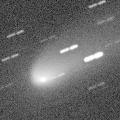
|
Now it is 12.6 mag (Mar. 21, Osamu Miyazaki). It stays 12 mag until spring.
Date(TT) R.A. (2000) Decl. Delta r Elong. m1 Best Time(A, h)
Apr. 1 17 39.85 -18 55.5 1.373 1.901 105 12.4 4:22 (348, 35)
Apr. 8 17 45.63 -18 48.4 1.338 1.936 110 12.4 4:11 (351, 36)
|
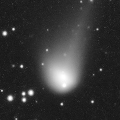
|
Now it is bright as 13.2 mag (Mar. 31, Osamu Miyazaki). It stays 13 mag until spring. It stays observable in good condition for a while after this.
Date(TT) R.A. (2000) Decl. Delta r Elong. m1 Best Time(A, h)
Apr. 1 15 43.76 12 57.0 4.176 4.891 131 13.0 3:09 ( 0, 68)
Apr. 8 15 42.33 14 15.8 4.154 4.919 135 13.0 2:40 ( 0, 69)
|
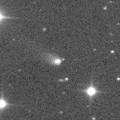
|
It brightened up to 14.5 mag in February (Feb. 16, Ken-ichi Kadota). It is expected to brighten up to 8 mag in July. Now it is not observable. In the Southern Hemisphere, it will appear in the morning sky at 13 mag in mid April, and it will be observable in excellent condition at the high light. In the Northern Hemisphere, it is not observable until June, and it becomes very low at the high lihght.
Date(TT) R.A. (2000) Decl. Delta r Elong. m1 Best Time(A, h)
Apr. 1 0 30.88 -10 57.4 3.163 2.216 15 13.5 4:22 (265,-25)
Apr. 8 0 33.09 -10 49.6 3.069 2.150 19 13.3 4:11 (268,-22)
|
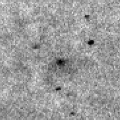
|
Now it is 13.2 mag (Mar. 30, Chris Wyatt). The condition is bad in this apparition. Appearing in the morning sky in the Southern Hemisphere. It is not observable until May in the Northern Hemisphere.
Date(TT) R.A. (2000) Decl. Delta r Elong. m1 Best Time(A, h)
Apr. 1 22 17.09 -17 31.9 2.334 1.715 41 13.3 4:22 (290, -2)
Apr. 8 22 34.75 -16 10.4 2.320 1.740 43 13.4 4:11 (289, -1)
|

|
Now it is 14.6 mag (Mar. 18, Chris Wyatt). The brightness evolution is slower than originally predicted. It stays 14 mag until summer. In the Southern Hemisphere, it stays observable in good condition for a long time. In the Northern Hemisphere, it is not observable until 2024 spring.
Date(TT) R.A. (2000) Decl. Delta r Elong. m1 Best Time(A, h)
Apr. 1 3 55.95 -20 4.4 2.485 2.064 54 13.7 19:46 ( 60, 6)
Apr. 8 4 5.52 -20 56.9 2.503 2.051 52 13.7 19:53 ( 63, 1)
|
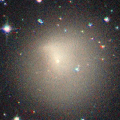
|
Now it is 13.8 mag (Mar. 6, Ken-ichi Kadota).
Date(TT) R.A. (2000) Decl. Delta r Elong. m1 Best Time(A, h)
Apr. 1 6 21.89 27 46.5 6.105 6.085 84 13.8 19:46 ( 83, 63)
Apr. 8 6 24.58 27 36.5 6.218 6.088 77 13.9 19:53 ( 88, 57)
|
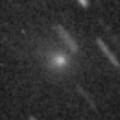
|
Now it is 13.2 mag (Mar. 2, Giuseppe Pappa). In the Southern Hemisphere, it stays observable in good condition after this. In the Northern Hemisphere, it is not observable after this.
Date(TT) R.A. (2000) Decl. Delta r Elong. m1 Best Time(A, h)
Apr. 1 22 3.62 -47 48.5 1.708 1.524 62 14.0 4:22 (317,-17)
Apr. 8 22 31.09 -52 13.8 1.699 1.610 67 14.2 4:11 (320,-21)
|
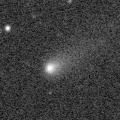
|
Now it is 14.4 mag (Mar. 30, Chris Wyatt). It will brighten rapidly up to 14 mag and will be observable in excellent condition in spring. In the Northern Hemisphere, it was observable in good condition in winter, but it becomes somewhat low in spring.
Date(TT) R.A. (2000) Decl. Delta r Elong. m1 Best Time(A, h)
Apr. 1 14 25.94 -25 41.3 1.449 2.349 146 14.1 1:52 ( 0, 29)
Apr. 8 14 19.55 -27 4.2 1.412 2.349 153 14.0 1:18 ( 0, 28)
|

|
It approaches to Sun down to 0.08 a.u. on Apr. 2, and it will brighten up to 13 mag. But it is not observable at that time. In the Northern Hemisphere, it appears in the evening sky in early April, but it will be fainter than 18 mag.
Date(TT) R.A. (2000) Decl. Delta r Elong. m1 Best Time(A, h)
Apr. 1 0 31.81 0 5.4 1.067 0.106 4 14.2 4:22 (257,-19)
Apr. 8 1 39.05 21 9.6 0.900 0.290 16 17.9 19:53 (119, -2)
|
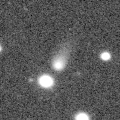
|
Now it is 14.6 mag (Mar. 18, Chris Wyatt). It is expected to brighten up to 7 mag in early 2024. In the Southern Hemisphere, it stays observable in good condition for a long time. It locates low in the Northern Hemisphere.
Date(TT) R.A. (2000) Decl. Delta r Elong. m1 Best Time(A, h)
Apr. 1 5 21.23 -29 53.6 4.356 4.216 75 14.4 19:46 ( 39, 12)
Apr. 8 5 25.26 -28 59.2 4.344 4.148 72 14.4 19:53 ( 45, 9)
|
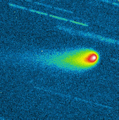
|
Now it is 14.9 mag (Mar. 19, Masayoshi Yoshimi). It stays 14 mag in 2023. It will be unobservable soon. Then it is not observable until May in the Southern Hemisphere, or until June in the Northern Hemisphere.
Date(TT) R.A. (2000) Decl. Delta r Elong. m1 Best Time(A, h)
Apr. 1 2 33.89 -4 37.9 4.106 3.278 29 14.7 19:46 ( 85, 0)
Apr. 8 2 34.50 -3 34.0 4.151 3.268 24 14.7 19:53 ( 91, -7)
|
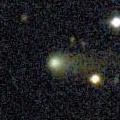
|
Now it is 14.7 mag (Mar. 27, W. Pei). It stays 14.5 mag and observable in good condition until spring.
Date(TT) R.A. (2000) Decl. Delta r Elong. m1 Best Time(A, h)
Apr. 1 9 23.08 29 25.0 2.764 3.403 122 14.7 20:46 ( 0, 84)
Apr. 8 9 25.44 29 25.5 2.853 3.413 116 14.8 20:21 ( 0, 84)
|
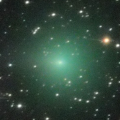
|
It brightened up to 9.7 mag in autumn (Oct. 23, Marco Goiato). Now it is fading. It has already faded down to 12.9 mag (Mar. 14, Thomas Lehmann). In the Southern Hemisphere, it stays observable in good condition for a long time. It locates low in the Northern Hemisphere.
Date(TT) R.A. (2000) Decl. Delta r Elong. m1 Best Time(A, h)
Apr. 1 18 21.87 -43 59.9 1.884 2.224 96 14.8 4:22 (344, 9)
Apr. 8 17 59.02 -44 50.6 1.786 2.282 106 15.0 4:11 (352, 9)
|
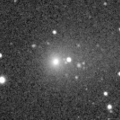
|
Now it is 13.9 mag (Mar. 27, W. Pei). It will be fading after this. It stays observable in good condition for a while.
Date(TT) R.A. (2000) Decl. Delta r Elong. m1 Best Time(A, h)
Apr. 1 8 41.18 20 57.8 1.471 2.114 116 14.9 20:04 ( 0, 76)
Apr. 8 8 48.45 20 58.6 1.566 2.142 111 15.1 19:53 ( 8, 76)
|
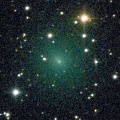
|
It brightened very rapidly up to 9.6 mag in late January (Jan. 25, Toshihiko Ikemura, Hirohisa Sato). Now it is fading. It has already faded down to 14.1 mag (Mar. 19, Ken-ichi Kadota). It stays observable in good condition for a long time.
Date(TT) R.A. (2000) Decl. Delta r Elong. m1 Best Time(A, h)
Apr. 1 6 53.70 -1 49.6 1.349 1.730 93 15.1 19:46 ( 34, 48)
Apr. 8 7 5.05 -3 56.0 1.479 1.793 90 15.7 19:53 ( 40, 43)
|
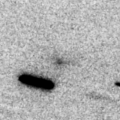
|
Now it is 15.8 mag (Mar. 24, B. Lutkenhoner, E. Cortes, N. Paul). It approaches to Sun down to 0.8 a.u. in April, and it brightens up to 15 mag. In the Southern Hemisphere, it stays observable in the extremely low sky. In the Northern Hemisphere, it is not observable after this.
Date(TT) R.A. (2000) Decl. Delta r Elong. m1 Best Time(A, h)
Apr. 1 22 45.99 -9 19.8 1.523 0.847 31 15.3 4:22 (279, -3)
Apr. 8 23 21.39 -6 10.7 1.554 0.834 28 15.1 4:11 (274, -5)
|
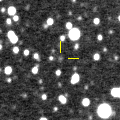
|
Now it is 15.6 mag (Mar. 29, Thomas Lehmann). It will brighten up to 13 mag from 2024 to 2025. It is observable in excllent condition in the Southern Hemisphere. It locates low in the Northern Hemisphere.
Date(TT) R.A. (2000) Decl. Delta r Elong. m1 Best Time(A, h)
Apr. 1 8 43.75 -35 29.6 5.846 6.370 117 15.2 20:06 ( 0, 19)
Apr. 8 8 43.93 -34 41.7 5.862 6.339 114 15.2 19:53 ( 3, 20)
|
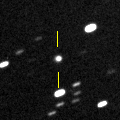
|
Now it is 15.4 mag (Mar. 5, Giuseppe Pappa). It is expected to brighten up to 12 mag from 2024 to 2025.
Date(TT) R.A. (2000) Decl. Delta r Elong. m1 Best Time(A, h)
Apr. 1 9 10.53 -10 1.6 5.173 5.841 127 15.3 20:33 ( 0, 45)
Apr. 8 9 6.33 -8 49.0 5.219 5.798 120 15.3 20:01 ( 0, 46)
|

|
It brightened up to 13.4 mag in last summer (July 7, Giuseppe Pappa). Now it is fading. It has already faded down to 15.5 mag (Mar. 3, Ken-ichi Kadota). It stays 15-16 mag until summer. It stays observable in good condition for a while.
Date(TT) R.A. (2000) Decl. Delta r Elong. m1 Best Time(A, h)
Apr. 1 18 2.25 11 32.3 3.250 3.534 98 15.4 4:22 (324, 62)
Apr. 8 17 57.57 14 8.0 3.187 3.571 104 15.4 4:11 (332, 67)
|
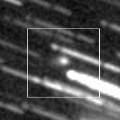
|
Now it is 16.1 mag (Mar. 26, D. Buczynski). It is expected to brighten up to 11.5 mag in 2024 spring. It stays observable in good condition for a long time. At the high light, it will be observable in excellent condition in the Southern Hemisphere, but it will be low in the Northern Hemisphere.
Date(TT) R.A. (2000) Decl. Delta r Elong. m1 Best Time(A, h)
Apr. 1 18 33.26 18 28.5 4.255 4.373 90 15.6 4:22 (301, 63)
Apr. 8 18 29.98 19 11.4 4.103 4.322 95 15.4 4:11 (308, 67)
|

|
Now it is 14.8 mag (Dec. 8, ATLAS Chile). In the Southern Hemisphere, apperaing in the morning sky. In the Northern Hemisphere, it will become observable in late May.
Date(TT) R.A. (2000) Decl. Delta r Elong. m1 Best Time(A, h)
Apr. 1 23 6.96 -13 9.7 4.144 3.303 28 15.4 4:22 (279, -9)
Apr. 8 23 16.15 -12 17.0 4.109 3.316 33 15.4 4:11 (280, -7)
|

|
Now it is 16.1 mag (Mar. 9, B. Lutkenhoner, N. Paul, E. Cortes). It will brighten rapidly up to 13.5 mag in summer. In the Southern Hemisphere, it stays observable until August. In the Northern Hemisphere, it is not observable until June. But it stays observable in good condition after that.
Date(TT) R.A. (2000) Decl. Delta r Elong. m1 Best Time(A, h)
Apr. 1 23 14.77 -33 1.5 2.616 1.994 42 15.8 4:22 (296,-21)
Apr. 8 23 29.58 -30 24.1 2.555 1.958 43 15.6 4:11 (294,-20)
|
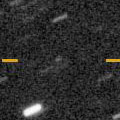
|
Now it is 16.5 mag (Mar. 18, J.-C. Merlin). It stays observable at 14-15 mag from spring to autumn. It locates somewhat low in the Northern Hemisphere.
Date(TT) R.A. (2000) Decl. Delta r Elong. m1 Best Time(A, h)
Apr. 1 18 18.80 -14 53.5 2.779 3.051 96 15.8 4:22 (335, 36)
Apr. 8 18 23.93 -15 15.7 2.672 3.036 101 15.7 4:11 (339, 37)
|
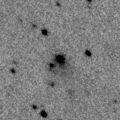
|
It approached to Sun down to 0.1 a.u. on Jan. 31. It was bright as 7.0-7.5 mag in early February (Feb. 5, Michael Jager). Now it is fading rapidly. It has already faded down to 13.2 mag (Mar. 24, Thomas Lehmann). It stays observable after this while the comet will be fading.
Date(TT) R.A. (2000) Decl. Delta r Elong. m1 Best Time(A, h)
Apr. 1 20 20.14 -8 26.0 1.573 1.479 65 15.7 4:22 (302, 25)
Apr. 8 20 18.82 -8 48.6 1.564 1.591 72 16.1 4:11 (306, 28)
|
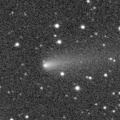
|
It continued brightening even after the perihelion passage. Now it is 15.5 mag (Mar. 15, Thomas Lehmann). It will be fading after this, and it will be fainter than 18 mag in July. It is observable in good condition in the Northern Hemisphere. It locates somewhat low in the Southern Hemisphere.
Date(TT) R.A. (2000) Decl. Delta r Elong. m1 Best Time(A, h)
Apr. 1 7 40.30 25 35.6 2.418 2.799 101 15.8 19:46 ( 47, 77)
Apr. 8 7 46.28 25 24.1 2.532 2.823 96 16.0 19:53 ( 63, 72)
|
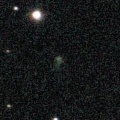
|
Now it is 16.8 mag (Mar. 28, Thomas Lehmann). It will brighten up to 13 mag in summer. In the Northern Hemisphere, it stays observable in good condition for a long time. In the Southern Hemisphere, it is not observable until August.
Date(TT) R.A. (2000) Decl. Delta r Elong. m1 Best Time(A, h)
Apr. 1 2 21.74 67 43.2 1.988 1.823 65 16.1 19:46 (153, 32)
Apr. 8 2 16.87 66 17.4 2.023 1.764 60 16.0 19:53 (153, 28)
|
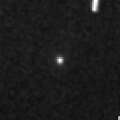
|
Now it is 17.4 mag (Mar. 25, Catalina Sky Survey). It will brighten up to 13 mag from June to August. In the Northern Hemisphere, it stays observable in excellent condition. In the Southern Hemisphere, it becomes unobservable from late April to early August.
Date(TT) R.A. (2000) Decl. Delta r Elong. m1 Best Time(A, h)
Apr. 1 12 41.60 31 32.8 0.835 1.746 144 16.5 0:08 ( 0, 86)
Apr. 8 12 36.27 37 23.8 0.800 1.667 135 16.2 23:30 (180, 87)
|
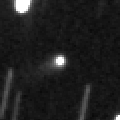
|
Now it is 15.9 mag (Mar. 14, Hirohisa Sato). It stays observable at 16 mag for a long time from early 2023 to early 2024. In the Northern Hemisphere, it is observable only until 2023 spring.
Date(TT) R.A. (2000) Decl. Delta r Elong. m1 Best Time(A, h)
Apr. 1 8 34.30 -7 29.8 3.454 4.035 119 16.3 19:56 ( 0, 47)
Apr. 8 8 29.25 -7 46.3 3.531 4.011 111 16.3 19:53 ( 10, 47)
|
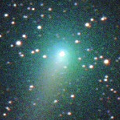
|
It brightened up to 9.3 mag in early summer in 2022 (June 5, Chris Wyatt). Now it is fading. It has already faded down to 16.6 mag (Mar. 19, Toshihiko Ikemura, Hirohisa Sato). In the Southen Hemisphere, it stays observable in good condition for a long time. It locates somewhat low in the Northern Hemisphere.
Date(TT) R.A. (2000) Decl. Delta r Elong. m1 Best Time(A, h)
Apr. 1 6 41.19 -12 2.7 3.705 3.860 91 16.3 19:46 ( 32, 37)
Apr. 8 6 41.93 -10 11.7 3.871 3.924 85 16.5 19:53 ( 42, 35)
|

|
It was observed at 15 mag from 2021 to 2022. Now it is fading. Now it is 17.5 mag (Mar. 28, ATLAS South Africa). In the Southern Hemisphere, it stays observable in excellent condition for a long time. In the Northern Hemiphere, it is not observable after this.
Date(TT) R.A. (2000) Decl. Delta r Elong. m1 Best Time(A, h)
Apr. 1 13 43.14 -73 36.6 5.906 6.318 109 16.4 1:11 ( 0,-19)
Apr. 8 13 20.34 -73 51.2 5.890 6.349 113 16.4 0:20 ( 0,-19)
|
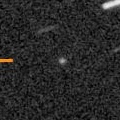
|
Now it is 16.9 mag (Mar. 19, Toshihiko Ikemura, Hirohisa Sato). It is observable at 16.5 mag in good condition in spring. It locates somewhat low in the Southern Hemisphere.
Date(TT) R.A. (2000) Decl. Delta r Elong. m1 Best Time(A, h)
Apr. 1 8 22.08 27 35.5 1.702 2.254 110 16.5 19:46 ( 1, 82)
Apr. 8 8 27.95 27 0.9 1.769 2.247 105 16.5 19:53 ( 40, 80)
|
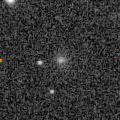
|
Now it is 17.0 mag (Mar. 14, ATLAS Chile). It moves along an almost circular orbit. It seems to be bright temporarily in outburst.
Date(TT) R.A. (2000) Decl. Delta r Elong. m1 Best Time(A, h)
Apr. 1 10 40.39 26 12.3 5.361 6.141 138 16.5 22:02 ( 0, 81)
Apr. 8 10 38.36 26 10.9 5.433 6.141 131 16.6 21:33 ( 0, 81)
|
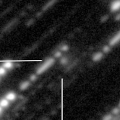
|
Now it is 15.8 mag (Mar. 25, ATLAS Chile). It brightens up to 16 mag from March to April. In the Southern Hemisphere, it stays observable in excellent condition. In the Northern Hemisphere, it will be getting higher gradually after this.
Date(TT) R.A. (2000) Decl. Delta r Elong. m1 Best Time(A, h)
Apr. 1 11 57.53 -44 21.5 0.886 1.765 138 16.7 23:20 ( 0, 11)
Apr. 8 12 3.98 -39 32.5 0.869 1.782 144 16.7 22:59 ( 0, 16)
|
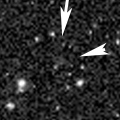
|
Now it is 16.8 mag (Mar. 19, ATLAS South Africa). Very far object. It stays 16-17 mag for a long time from 2021 to 2026. In the Southern Hemisphere, it stays observable in good condition for a long time. In the Northern Hemisphere, it is not observable at all.
Date(TT) R.A. (2000) Decl. Delta r Elong. m1 Best Time(A, h)
Apr. 1 4 55.73 -70 39.0 10.412 10.385 85 16.8 19:46 ( 16,-22)
Apr. 8 4 55.95 -70 3.3 10.400 10.381 86 16.8 19:53 ( 19,-24)
|
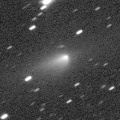
|
It brightened up to 12.7 mag in last year (Feb. 27, 2022, Jose Guilherme de S. Aguiar). Now it is fading. It has already faded down to 17.1 mag (Mar. 17, J.-C. Merlin). In the Southern Hemisphere, it stays observable until summer when it becomes fainter than 18 mag. It locates low in the Northern Hemisphere.
Date(TT) R.A. (2000) Decl. Delta r Elong. m1 Best Time(A, h)
Apr. 1 19 37.53 -24 58.1 2.799 2.781 78 16.8 4:22 (322, 19)
Apr. 8 19 44.96 -24 49.6 2.731 2.807 83 16.9 4:11 (324, 20)
|
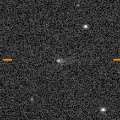
|
Now it is 16.8 mag (Mar. 15, Ken-ichi Kadota). It will be fading after this, and it will be fainter than 18 mag in early May. It locates somewhat low in the Southern Hemisphere.
Date(TT) R.A. (2000) Decl. Delta r Elong. m1 Best Time(A, h)
Apr. 1 13 32.02 29 4.4 0.486 1.423 144 16.9 0:58 ( 0, 84)
Apr. 8 13 28.29 27 30.6 0.525 1.463 145 17.1 0:26 ( 0, 82)
|
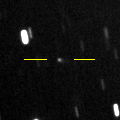
|
Now it is 17.6 mag (Mar. 28, ATLAS-HKO, Haleakala). In the Northern Hemisphere, it stays observable at 17 mag in good condition from spring to summer. In the Southern Hemisphere, it locates extremely low only in summer.
Date(TT) R.A. (2000) Decl. Delta r Elong. m1 Best Time(A, h)
Apr. 1 13 12.43 54 9.4 2.521 3.156 121 17.0 0:38 (180, 71)
Apr. 8 13 9.61 55 9.8 2.533 3.130 117 17.0 0:08 (180, 70)
|
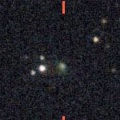
|
Now it is 15.8 mag (Mar. 19, Toshihiko Ikemura, Hirohisa Sato). It will be fading after this, and it will be fainter than 18 mag in early May. It is observable in excellent condition in the Northern Hemisphere. It locates low in the Southern Hemisphere.
Date(TT) R.A. (2000) Decl. Delta r Elong. m1 Best Time(A, h)
Apr. 1 7 18.17 39 10.6 1.466 1.842 94 17.0 19:46 (111, 76)
Apr. 8 7 15.19 33 26.8 1.588 1.853 88 17.2 19:53 ( 92, 69)
|
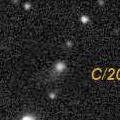
|
Now it is 16.7 mag (Mar. 18, ATLAS Chile). It stays 17 mag and observable in good condition until summer.
Date(TT) R.A. (2000) Decl. Delta r Elong. m1 Best Time(A, h)
Apr. 1 12 59.00 11 20.5 7.982 8.945 163 17.0 0:25 ( 0, 66)
Apr. 8 12 54.33 11 52.7 7.999 8.952 161 17.1 23:48 ( 0, 67)
|
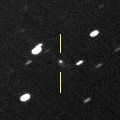
|
Now it is 16.8 mag (Mar. 19, Toshihiko Ikemura, Hirohisa Sato). It stays observable at 17 mag from spring to early summer. It locates low in the Southern Hemisphere.
Date(TT) R.A. (2000) Decl. Delta r Elong. m1 Best Time(A, h)
Apr. 1 9 9.87 37 25.6 1.986 2.585 116 17.2 20:33 (180, 88)
Apr. 8 9 12.21 36 48.5 2.050 2.574 110 17.2 20:08 (180, 88)
|

|
Now it is 17.1 mag (Apr. 3, Ken-ichi Kadota). It was regarded as an asteroid, but its cometary activity was detected. It will be fading after this, and it will be fainter than 18 mag in late April.
Date(TT) R.A. (2000) Decl. Delta r Elong. m1 Best Time(A, h)
Apr. 1 5 51.01 16 52.7 1.273 1.434 77 17.3 19:46 ( 71, 52)
Apr. 8 6 15.29 16 37.9 1.326 1.458 76 17.5 19:53 ( 73, 50)
|
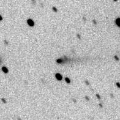
|
Now it is 17.1 mag (Mar. 13, Catalina Sky Survey). It will be fading and getting lower gradually after this. It will be unobservable in April in the Northern Hemisphere, or in May in the Southern Hemisphere.
Date(TT) R.A. (2000) Decl. Delta r Elong. m1 Best Time(A, h)
Apr. 1 4 44.60 5 12.2 3.943 3.569 61 17.3 19:46 ( 73, 32)
Apr. 8 4 52.08 5 42.8 4.032 3.577 56 17.4 19:53 ( 78, 27)
|
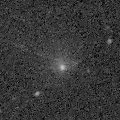
|
Now it is 17.1 mag (Mar. 13, ATLAS Chile). Very large comet. It is expected to brighten up to 14 mag in 2031. In the Southern Hemisphere, it stays observable in good condition for a long time. In the Northern Hemisphere, it is not observable until 2030.
Date(TT) R.A. (2000) Decl. Delta r Elong. m1 Best Time(A, h)
Apr. 1 2 42.07 -57 34.8 18.199 17.826 66 17.3 19:46 ( 37,-27)
Apr. 8 2 44.81 -57 26.9 18.160 17.801 67 17.3 19:53 ( 39,-31)
|
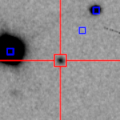
|
It will approach to Sun down to 0.4 a.u. in late September in 2024, and it is expected to brighten up to 0 mag. Now it is 17.3 mag (Mar. 18, Toshihiko Ikemura, Hirohisa Sato). It stays observable in good condition for a while. At the high light, in the Northern Hemisphere, it will be observable in good condition after the perihelion passage. In the Southern Hemisphere, it will be observable in the low sky before and after the perihelion passage.
Date(TT) R.A. (2000) Decl. Delta r Elong. m1 Best Time(A, h)
Apr. 1 15 10.68 0 31.6 6.166 6.980 141 17.4 2:36 ( 0, 55)
Apr. 8 15 6.83 0 55.8 6.043 6.917 148 17.3 2:05 ( 0, 56)
|
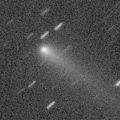
|
It brightened up to 14.1 mag in autumn (Nov. 14, Thomas Lehmann). Now it is fading. It has already faded down to 17.0 mag (Mar. 19, Ken-ichi Kadota). In the Northern Hemisphere, it stays observable in excellent condition for a while. In the Southern Hemisphere, it is not observable after this.
Date(TT) R.A. (2000) Decl. Delta r Elong. m1 Best Time(A, h)
Apr. 1 4 5.85 36 43.3 3.163 2.755 57 17.4 19:46 (112, 39)
Apr. 8 4 19.57 37 14.2 3.259 2.783 53 17.5 19:53 (114, 35)
|

|
It brightened very rapidly up to 15.5 mag from last autumn to last winter (Nov. 2, 2021, Toshihiko Ikemura, Hirohisa Sato). Now it is fading slowly. It has already faded down to 16.8 mag (Mar. 19, Toshihiko Ikemura, Hirohisa Sato).
Date(TT) R.A. (2000) Decl. Delta r Elong. m1 Best Time(A, h)
Apr. 1 6 20.66 11 22.1 4.733 4.745 84 17.4 19:46 ( 57, 54)
Apr. 8 6 24.49 11 31.6 4.859 4.766 78 17.5 19:53 ( 65, 48)
|
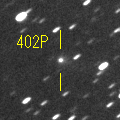
|
It brightened up to 15.3 mag in last winter (Jan. 12, 2022, H. Nohara). Now it is fading. It has already faded down to 17.2 mag (Mar. 15, ATLAS-HKO, Haleakala). It will be fainter than 18 mag in May. It locates low in the Southern Hemisphere.
Date(TT) R.A. (2000) Decl. Delta r Elong. m1 Best Time(A, h)
Apr. 1 9 51.55 31 14.4 4.058 4.722 126 17.5 21:14 ( 0, 86)
Apr. 8 9 50.62 31 19.9 4.163 4.742 119 17.5 20:46 ( 0, 86)
|
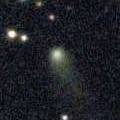
|
Now it is 17.3 mag (Mar. 10, Catalina Sky Survey). Fading slowly. In the Southern Hemisphere, it is not observable after this.
Date(TT) R.A. (2000) Decl. Delta r Elong. m1 Best Time(A, h)
Apr. 1 18 48.03 54 19.8 6.319 6.315 85 17.5 4:22 (216, 63)
Apr. 8 18 50.80 55 35.8 6.336 6.350 86 17.5 4:11 (211, 64)
|

|
Now it is 17.1 mag (Mar. 28, ATLAS-HKO, Haleakala). Fading slowly. In the Northern Hemisphere, it stays observable in good condition for a long time. In the Southern Hemisphere, it is not observable after this.
Date(TT) R.A. (2000) Decl. Delta r Elong. m1 Best Time(A, h)
Apr. 1 18 31.51 73 55.9 9.836 9.825 86 17.5 4:22 (190, 49)
Apr. 8 18 28.49 74 53.8 9.867 9.843 85 17.5 4:11 (187, 49)
|
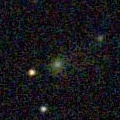
|
It brightened rapidly. Now it is 16.9 mag (Mar. 14, Purple Mountain Observatory, XuYi Station). It will be fading after this. It will be fainter than 18 mag in April.
Date(TT) R.A. (2000) Decl. Delta r Elong. m1 Best Time(A, h)
Apr. 1 9 54.09 21 50.3 1.372 2.170 131 17.6 21:17 ( 0, 77)
Apr. 8 9 56.72 21 26.0 1.459 2.201 125 17.9 20:52 ( 0, 76)
|
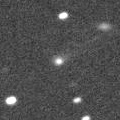
|
It brightened up to 15.9 mag in 2022 spring (May 5, Toshiyuki Takahashi). Now it is 17.4 mag (Mar. 18, J.-C. Merlin). In 2023, it is observable at 17.5 mag in spring.
Date(TT) R.A. (2000) Decl. Delta r Elong. m1 Best Time(A, h)
Apr. 1 16 31.53 -24 30.5 4.302 4.888 120 17.7 3:57 ( 0, 30)
Apr. 8 16 30.93 -24 35.8 4.218 4.895 127 17.6 3:29 ( 0, 30)
|
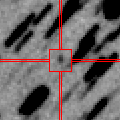
|
Now it is 17.8 mag (Feb. 27, H. Nohara). It returns for the first time in 70 years. It will brighten up to 4.5 mag in 2024 spring. In the Northern Hemisphere, it stays observable in good condition until 2024 spring while the comet will be brightening gradually. In the Southern Hemisphere, it is observable only in 2023 spring in the extremely low sky before the perihelion passage.
Date(TT) R.A. (2000) Decl. Delta r Elong. m1 Best Time(A, h)
Apr. 1 19 30.24 35 35.8 5.079 4.954 77 17.9 4:22 (258, 59)
Apr. 8 19 32.83 37 3.1 4.958 4.890 80 17.8 4:11 (256, 62)
|
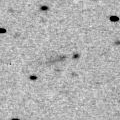
|
Now it is 19.3 mag (Mar. 27, A. Diepvens). Fading rapidly. It looks elongated.
Date(TT) R.A. (2000) Decl. Delta r Elong. m1 Best Time(A, h)
Apr. 1 10 6.22 16 20.5 3.394 4.180 136 17.9 21:28 ( 0, 71)
Apr. 8 10 5.23 16 26.8 3.467 4.179 129 17.9 21:00 ( 0, 71)
|
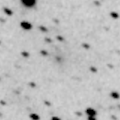
|
Now it is 17.9 mag (Mar. 21, John Maikner). It will be getting higher gradually, but it will be fading after this.
Date(TT) R.A. (2000) Decl. Delta r Elong. m1 Best Time(A, h)
Apr. 1 21 8.09 -0 55.7 2.414 1.981 53 17.9 4:22 (287, 21)
Apr. 8 21 19.43 1 25.5 2.393 2.020 56 18.0 4:11 (286, 24)
|

|
It will brighten up to 16.5 mag in summer. It stays observable in good condition for a long time.
Date(TT) R.A. (2000) Decl. Delta r Elong. m1 Best Time(A, h)
Apr. 1 21 36.95 -11 33.1 3.651 3.073 48 17.9 4:22 (291, 9)
Apr. 8 21 46.59 -11 2.5 3.573 3.068 52 17.9 4:11 (292, 11)
|
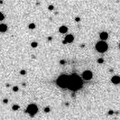
|
Now it is 18.4 mag (Mar. 18, ATLAS-HKO, Haleakala). It will be fading after this, and it will be fainter than 18 mag in April. It locates somewhat low in the Southern Hemisphere.
Date(TT) R.A. (2000) Decl. Delta r Elong. m1 Best Time(A, h)
Apr. 1 6 5.75 25 30.7 3.993 3.955 80 17.9 19:46 ( 82, 59)
Apr. 8 6 11.29 25 25.6 4.098 3.958 74 17.9 19:53 ( 87, 53)
|

|
It has not been observed yet in this apparition. It will brighten rapidly up to 11 mag in July. It stays extremely low in this apparition.
Date(TT) R.A. (2000) Decl. Delta r Elong. m1 Best Time(A, h)
Apr. 1 21 42.30 -2 41.1 2.222 1.668 44 18.4 4:22 (283, 14)
Apr. 8 22 1.95 -0 49.1 2.121 1.602 46 17.9 4:11 (281, 14)
|
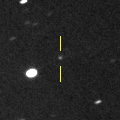
|
Now it is 17.9 mag (Mar. 10, A. Diepvens). It will brighten up to 15 mag from 2024 to 2025. In 2023, it is observable at 18 mag in spring.
Date(TT) R.A. (2000) Decl. Delta r Elong. m1 Best Time(A, h)
Apr. 1 9 27.94 26 17.6 3.675 4.321 124 17.9 20:50 ( 0, 81)
Apr. 8 9 26.61 26 8.2 3.752 4.309 117 17.9 20:22 ( 0, 81)
|
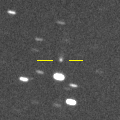
|
It was predicted to brighten up to 16 mag in 2023. But actually, it is very faint as 18.7 mag (Mar. 25, ATLAS Chile). In the Southern Hemisphere, it stays observable in good condition for a long time. In the Northern Hemisphere, it will never be observable again.
Date(TT) R.A. (2000) Decl. Delta r Elong. m1 Best Time(A, h)
Apr. 1 19 44.70 -74 60.0 3.121 3.275 89 18.0 4:22 (349,-23)
Apr. 8 20 6.03 -75 18.1 3.080 3.285 92 18.0 4:11 (349,-24)
|
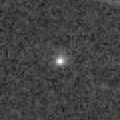
|
It was observed at 17 mag in 2022 autumn. It was predicted to be observable at 17 mag also in 2023 spring. But actually, it is extremely faint as 19.7 mag (Apr. 1, Taras Prystavski).
Date(TT) R.A. (2000) Decl. Delta r Elong. m1 Best Time(A, h)
Apr. 1 20 14.88 6 26.1 1.979 1.815 65 19.6 4:22 (290, 36)
Apr. 8 20 4.49 8 38.6 1.855 1.855 74 19.6 4:11 (294, 43)
|
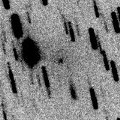
|
Tiny comet, but it approached to Sun down to 0.8 a.u. in January, and it will approach to Earth down to 0.6 a.u. in March. It was expected to brighten up to 14 mag from January to March. But actually, it became disintegrated before the perihelion passage. Now it is extremely faint as 18.2 mag (Feb. 20, Thomas Lehmann). In the Southern Hemisphere, it stays observable in good condition for a long time. It becomes observable in good condition after this also in the Northern Hemisphere.
Date(TT) R.A. (2000) Decl. Delta r Elong. m1 Best Time(A, h)
Apr. 1 7 31.03 5 54.1 0.899 1.480 102 20.3 19:46 ( 25, 59)
Apr. 8 7 49.72 12 26.3 1.061 1.573 99 20.9 19:53 ( 38, 63)
|

|
In the last apparition, it had faded before the perihelion passage. It was expected to brighten up to 17 mag if it would become as bright as its last apparition. But actually, it is extremely faint as 22.2 mag (Mar. 27, Pan-STARRS 1, Haleakala). It stays observable in good condition for a long time.
Date(TT) R.A. (2000) Decl. Delta r Elong. m1 Best Time(A, h)
Apr. 1 14 12.39 4 44.6 1.836 2.774 155 21.7 1:38 ( 0, 60)
Apr. 8 14 9.34 5 29.7 1.799 2.760 159 21.7 1:07 ( 0, 60)
|
|
![]()
 C/2021 S3 ( PanSTARRS )
C/2021 S3 ( PanSTARRS ) C/2021 X1 ( Maury-Attard )
C/2021 X1 ( Maury-Attard ) C/2020 S4 ( PanSTARRS )
C/2020 S4 ( PanSTARRS ) C/2022 P1 ( NEOWISE )
C/2022 P1 ( NEOWISE ) 118P/Shoemaker-Levy 4
118P/Shoemaker-Levy 4 C/2022 U2 ( ATLAS )
C/2022 U2 ( ATLAS ) 300P/Catalina
300P/Catalina C/2021 G2 ( ATLAS )
C/2021 G2 ( ATLAS ) C/2022 E2 ( ATLAS )
C/2022 E2 ( ATLAS ) C/2020 R7 ( ATLAS )
C/2020 R7 ( ATLAS ) C/2022 L2 ( ATLAS )
C/2022 L2 ( ATLAS ) 117P/Helin-Roman-Alu 1
117P/Helin-Roman-Alu 1 126P/IRAS
126P/IRAS 199P/Shoemaker 4
199P/Shoemaker 4 96P/Machholz 1
96P/Machholz 1 119P/Parker-Hartley
119P/Parker-Hartley C/2022 W3 ( Leonard )
C/2022 W3 ( Leonard ) C/2023 E1 ( ATLAS )
C/2023 E1 ( ATLAS ) C/2022 A3 ( Lemmon-ATLAS )
C/2022 A3 ( Lemmon-ATLAS ) C/2021 E3 ( ZTF )
C/2021 E3 ( ZTF ) C/2018 U1 ( Lemmon )
C/2018 U1 ( Lemmon ) 94P/Russell 4
94P/Russell 4 P/2023 B1 ( PanSTARRS )
P/2023 B1 ( PanSTARRS ) C/2023 B2 ( ATLAS )
C/2023 B2 ( ATLAS ) C/2019 E3 ( ATLAS )
C/2019 E3 ( ATLAS ) 116P/Wild 4
116P/Wild 4 263P/Gibbs
263P/Gibbs C/2022 U4 ( Bok )
C/2022 U4 ( Bok ) C/2023 A1 ( Leonard )
C/2023 A1 ( Leonard ) C/2020 F2 ( ATLAS )
C/2020 F2 ( ATLAS ) 180P/NEAT
180P/NEAT P/2010 VH95 ( Catalina )
P/2010 VH95 ( Catalina ) 408P/2020 M7 ( Novichonok-Gerke )
408P/2020 M7 ( Novichonok-Gerke ) C/2014 UN271 ( Bernardinelli-Bernstein )
C/2014 UN271 ( Bernardinelli-Bernstein ) C/2023 A3 ( Tsuchinshan-ATLAS )
C/2023 A3 ( Tsuchinshan-ATLAS ) P/2022 L3 ( ATLAS )
P/2022 L3 ( ATLAS ) P/2021 N2 ( Fuls )
P/2021 N2 ( Fuls ) 402P/2020 Q3 ( LINEAR )
402P/2020 Q3 ( LINEAR ) C/2020 H6 ( ATLAS )
C/2020 H6 ( ATLAS ) C/2019 O3 ( Palomar )
C/2019 O3 ( Palomar ) 204P/LINEAR-NEAT
204P/LINEAR-NEAT 99P/Kowal 1
99P/Kowal 1 12P/Pons-Brooks
12P/Pons-Brooks 452P/2022 B5 ( Sheppard-Jewitt )
452P/2022 B5 ( Sheppard-Jewitt ) 80P/Peters-Hartley
80P/Peters-Hartley 287P/Christensen
287P/Christensen 244P/Scotti
244P/Scotti 185P/Petriew
185P/Petriew 65P/Gunn
65P/Gunn C/2021 C5 ( PanSTARRS )
C/2021 C5 ( PanSTARRS ) C/2022 Q2 ( ATLAS )
C/2022 Q2 ( ATLAS ) C/2022 S3 ( PanSTARRS )
C/2022 S3 ( PanSTARRS ) 280P/Larsen
280P/Larsen![]()
































































